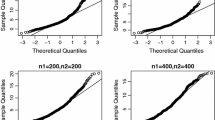Abstract
The paper deals with three approaches to comparing the regression lines corresponding to two dependent groups when using a robust estimator. The focus is on the Theil–Sen estimator with some comments about alternative estimators that might be used. The first approach is to test the global hypothesis that the two groups have equal intercepts and slopes in a manner that allows a heteroscedastic error term. The second approach is to test the hypothesis of equal intercepts, ignoring the slopes, and testing the hypothesis of equal slopes, ignoring the intercepts. The third approach is to test the hypothesis that the regression lines differ at a specified design point. This last goal corresponds to the classic Johnson and Neyman method when dealing with independent groups and when using the ordinary least squares regression estimator. Based on extant studies, there are guesses about how to proceed in a manner that will provide reasonably accurate control over the Type I error probability: Use some type of percentile bootstrap method. (Methods that assume the regression estimator is asymptotically normal were not considered for reasons reviewed in the paper.) But there are no simulation results providing some sense of how well they perform when dealing with a relatively small sample size. Data from the Well Elderly II study are used to illustrate that the choice between the ordinary least squares estimator and the Theil–Sen estimator can make a practical difference.

Similar content being viewed by others
References
Bradley JV (1978) Robustness? British J Math Stat Psychol 31:144–152
Chida Y, Steptoe A (2009) Cortisol awakening response and psychosocial factors: a systematic review and meta-analysis. Biol Psychol 80:265–278
Clark F, Jackson J, Carlson M, Chou C-P, Cherry BJ, Jordan-Marsh M, Knight BG, Mandel D, Blanchard J, Granger DA, Wilcox RR, Lai MY, White B, Hay J, Lam C, Marterella A, Azen SP (2012) Effectiveness of a lifestyle intervention in promoting the well-being of independently living older people: results of the well Elderly 2 randomise controlled trial. J Epidemiol Community Health 66:782–790. doi:10.1136/jech.2009.099754
Cleveland WS (1979) Robust locally weighted regression and smoothing scatterplots. J Am Stat Assoc 74:829–836
Cleveland WS, Devlin SJ (1988) Locally-weighted Regression: an approach to regression analysis by local fitting. J Am Stat Assoc 83:596–610
Clow A, Thorn L, Evans P, Hucklebridge F (2004) The awakening cortisol response: methodological issues and significance. Stress 7:29–37
Dietz EJ (1987) A comparison of robust estimators in simple linear regression. Commun Stat-Simul Comput 16: 1209–1227
Donoho DL, Gasko M (1992) Breakdown properties of the location estimates based on halfspace depth and projected outlyingness. Ann Stat 20:1803–1827
Eakman AM, Carlson ME, Clark FA (2010) The meaningful activity participation assessment: a measure of engagement in personally valued activities. Int J Aging Human Dev 70:299–317
Hampel FR, Ronchetti EM, Rousseeuw PJ, Stahel WA (1986) Robust statistics. Wiley, New York
Hoaglin DC (1985) Summarizing shape numerically: the g-and-h distribution. In: Hoaglin D, Mosteller F, Tukey J (eds) Exploring data tables trends and shapes. Wiley, New York, pp 461–515
Huber PJ, Ronchetti E (2009) Robust statistics, 2nd edn. Wiley, New York
Jackson J, Mandel D, Blanchard J, Carlson M, Cherry B, Azen S, Chou C-P, Jordan-Marsh M, Forman T, White B, Granger D, Knight B, Clark F (2009) Confronting challenges in intervention research with ethnically diverse older adults: the USC Well Elderly II trial. Clin Trials 6:90–101
Jöckel K-H (1986) Finite sample properties and asymptotic efficiency of Monte Carlo tests. Ann Stat 14:336–347
Johnson P, Neyman J (1936) Tests of certain linear hypotheses and their application to some educational problems. Stat Res Mem 1:57–93
Koenker R, Bassett G (1978) Regression quantiles. Econometrika 46:33–50
Peng H, Wang S, Wang X (2008) Consistency and asymptotic distribution of the Theil–Sen estimator. J Stat Plan Inference 138:1836–1850
Pratt JW (1968) A normal approximation for binomial, F, beta, and other common, related tail probabilities, I. J Am Stat Assoc 63:1457–1483
Racine J, MacKinnon JG (2007) Simulation-based tests than can use any number of simulations. Commun Stat-Simul Comput 36:357–365
Sen PK (1968) Estimate of the regression coefficient based on Kendall’s tau. J Am Stat Assoc 63:1379–1389
Serlin RC (2000) Testing for robustness in Monte Carlo studies. Psychol Methods 5:230–240
Staudte RG, Sheather SJ (1990) Robust estimation and testing. Wiley, New York
Theil H (1950) A rank-invariant method of linear and polynomial regression analysis. Indagationes Mathematicae 12:85–91
Wang XQ (2005) Asymptotics of the Theil–Sen estimator in simple linear regression models with a random covariate. Nonparametric Stat 17:107–120
Wilcox RR (1998) Simulation results on extensions of the Theil-Sen regression estimator. Commun Stat-Simul Comput 27: 1117–1126
Wilcox RR (2012) Introduction to robust estimation and hypothesis testing, 3rd edn. Academic Press, San Diego, CA
Wilcox RR, Clark F (2013) Within groups comparisons of least squares regression lines when there is heteroscedasticity. Submitted for publication Dornsife.usc.edu/cf/labs/wilcox/wilcox-faculty-display.cfm
Yohai VJ (1987) High breakdown point and high efficiency robust estimates for regression. Ann Stat 15:642–656
Author information
Authors and Affiliations
Corresponding author
Rights and permissions
About this article
Cite this article
Wilcox, R.R., Clark, F. Comparing robust regression lines associated with two dependent groups when there is heteroscedasticity. Comput Stat 29, 1175–1186 (2014). https://doi.org/10.1007/s00180-014-0485-2
Received:
Accepted:
Published:
Issue Date:
DOI: https://doi.org/10.1007/s00180-014-0485-2



